Chapter: Introduction to the Design and Analysis of Algorithms : Brute Force and Exhaustive Search
Exhaustive Search
Exhaustive
Search
Exhaustive Search:
1. Traveling Salesman Problem
2. Knapsack Problem
3. Assignment Problem
4. Exercises
Many
important problems require finding an element with a special property in a domain
that grows exponentially (or faster) with an instance size. Typically, such
problems arise in situations that involve—explicitly or
implicitly—combinatorial objects such as permutations, combinations, and
subsets of a given set. Many such problems are optimization problems: they ask
to find an element that maximizes or minimizes some desired characteristic such
as a path length or an assignment cost.
Exhaustive
search is simply a brute-force approach to combinatorial
prob-lems. It suggests generating each and every element of the problem domain,
se-lecting those of them that satisfy all the constraints, and then finding a
desired element (e.g., the one that optimizes some objective function). Note
that although the idea of exhaustive search is quite straightforward, its
implementation typically requires an algorithm for generating certain
combinatorial objects. We delay a dis-cussion of such algorithms until the next
chapter and assume here that they exist.
We
illustrate exhaustive search by applying it to three important problems: the
traveling salesman problem, the knapsack problem, and the assignment problem.
Traveling
Salesman Problem
The traveling
salesman problem (TSP) has been intriguing researchers for the last 150
years by its seemingly simple formulation, important applications, and
interesting connections to other combinatorial problems. In layman’s terms, the
problem asks to find the shortest tour through a given set of n cities that visits each city
exactly once before returning to the city where it started. The problem can be
conveniently modeled by a weighted graph, with the graph’s vertices
representing the cities and the edge weights specifying the distances. Then the
problem can be stated as the problem of finding the shortest Hamiltonian
circuit of the graph. (A Hamiltonian circuit is defined as a cycle that
passes through all the vertices of the graph exactly once. It is named after
the Irish mathematician Sir William Rowan Hamilton (1805–1865), who became
interested in such cycles as an application of his algebraic discoveries.)
It is
easy to see that a Hamiltonian circuit can also be defined as a sequence of n + 1
adjacent vertices vi0 , vi1, . . . , vin−1, vi0 , where the first vertex of the
sequence is the same as the last one and
all the other n − 1 vertices are distinct.
Further, we can assume, with no loss of generality, that all circuits start and
end at one particular vertex (they are cycles after all, are they not?). Thus,
we can get all the tours by generating all the permutations of n − 1
intermediate cities, compute the tour lengths, and find the shortest among
them. Figure 3.7 presents a small instance of the problem and its solution by
this method.
An
inspection of Figure 3.7 reveals three pairs of tours that differ only by their
direction. Hence, we could cut the number of vertex permutations by half. We
could, for example, choose any two intermediate vertices, say, b and c, and
then consider only permutations in which b precedes
c. (This trick implicitly defines
a tour’s direction.)
This
improvement cannot brighten the efficiency picture much, however. The total
number of permutations needed is still 21 (n − 1)!, which
makes the exhaustive-search approach impractical for all but very small values
of n. On the other hand, if you
always see your glass as half-full, you can claim that cutting the work by half
is nothing to sneeze at, even if you solve a small instance of the problem,
especially by hand. Also note that had we not limited our investigation to the
circuits starting at the same vertex, the number of permutations would have
been even larger, by a factor of n.
Knapsack
Problem
Here is
another well-known problem in algorithmics. Given n items of
known weights w1, w2, . . . , wn and
values v1, v2, . . . , vn and a
knapsack of capacity W , find
the most valuable subset of the items that fit into the knapsack. If you do not
like the idea of putting yourself in the shoes of a thief who wants to steal
the most
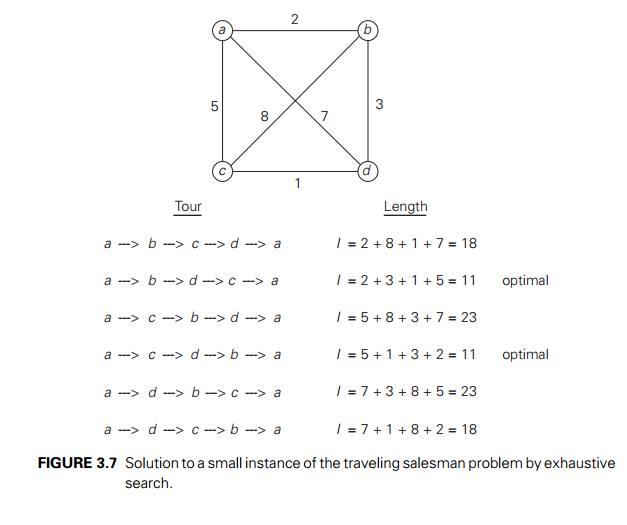
valuable
loot that fits into his knapsack, think about a transport plane that has to
deliver the most valuable set of items to a remote location without exceeding
the plane’s capacity. Figure 3.8a presents a small instance of the knapsack
problem.
The
exhaustive-search approach to this problem leads to generating all the subsets
of the set of n items
given, computing the total weight of each subset in order to identify feasible
subsets (i.e., the ones with the total weight not exceeding the knapsack
capacity), and finding a subset of the largest value among them. As an example,
the solution to the instance of Figure 3.8a is given in Figure 3.8b. Since the
number of subsets of an n-element
set is 2n, the exhaustive search leads to
a (2n)
algorithm,
no matter how efficiently individual subsets are generated.
Thus, for
both the traveling salesman and knapsack problems considered above, exhaustive
search leads to algorithms that are extremely inefficient on every input. In
fact, these two problems are the best-known examples of so-called NP-hard
problems. No polynomial-time algorithm is known for any NP-hard problem. Moreover, most computer
scientists believe that such algorithms do not exist, although this very
important conjecture has never been proven. More-sophisticated
approaches—backtracking and branch-and-bound (see Sec-tions 12.1 and
12.2)—enable us to solve some but not all instances of these and
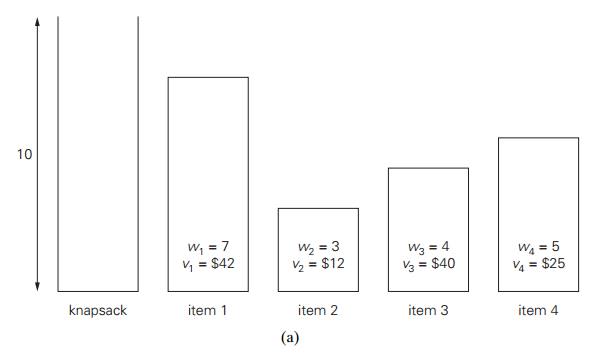
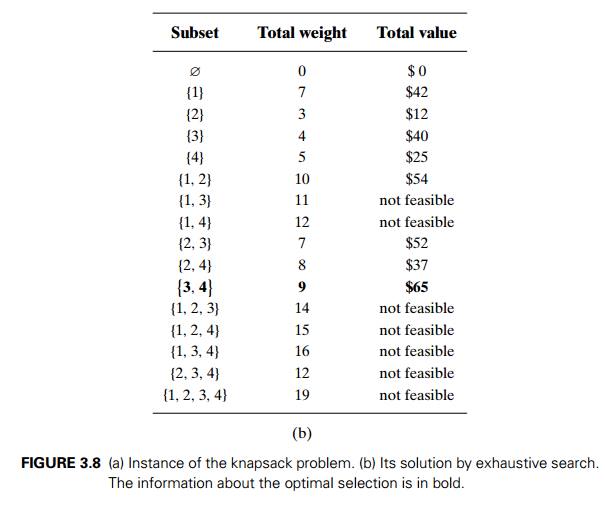
similar
problems in less than exponential time. Alternatively, we can use one of many
approximation algorithms, such as those described in Section 12.3.
Assignment
Problem
In our
third example of a problem that can be solved by exhaustive search, there are n people who need to be assigned
to execute n jobs, one person per job. (That
is, each person is assigned to exactly one job and each job is assigned to
exactly one person.) The cost that would accrue if the ith person is assigned to the j th job is a known quantity C[i,
j ] for each pair i, j = 1, 2, . . . , n. The
problem is to find an assignment with the minimum total cost.
A small
instance of this problem follows, with the table entries representing the
assignment costs C[i, j ]:
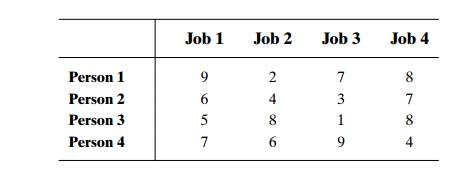
It is
easy to see that an instance of the assignment problem is completely specified
by its cost matrix C. In terms
of this matrix, the problem is to select one element in each row of the matrix
so that all selected elements are in different columns and the total sum of the
selected elements is the smallest possible. Note that no obvious strategy for
finding a solution works here. For example, we cannot select the smallest
element in each row, because the smallest elements may happen to be in the same
column. In fact, the smallest element in the entire matrix need not be a
component of an optimal solution. Thus, opting for the exhaustive search may
appear as an unavoidable evil.
We can
describe feasible solutions to the assignment problem as n-tuples j1, . . . , jn in which
the ith component, i = 1, . . . , n,
indicates the column of the element
selected in the ith row
(i.e., the job number assigned to the ith
person). For example, for the cost matrix above, 2, 3, 4, 1 indicates the
assignment of Person 1 to Job 2, Person 2 to Job 3, Person 3 to Job 4, and
Person 4 to Job 1. The requirements of the assignment problem imply that there
is a one-to-one correspondence between feasible assignments and permutations of
the first n integers. Therefore, the
exhaustive-search approach to the assignment problem would require generating
all the permutations of integers 1, 2, . . . , n,
computing the total cost of each assignment by summing up the corresponding
elements of the cost matrix, and finally selecting the one with the smallest
sum. A few first iterations of applying this algorithm to the instance given
above are shown in Figure 3.9; you are asked to complete it in the exercises.
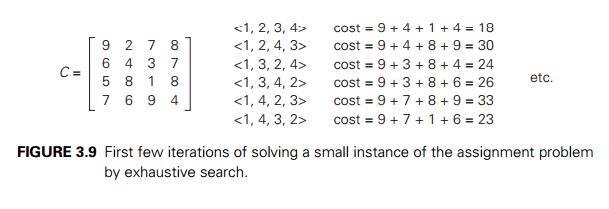
Since the
number of permutations to be considered for the general case of the assignment
problem is n!, exhaustive search is
impractical for all but very small instances of the problem. Fortunately, there
is a much more efficient algorithm for this problem called the Hungarian
method after the Hungarian mathematicians Konig¨ and Egervary,´ whose
work underlies the method (see, e.g., [Kol95]).
This is
good news: the fact that a problem domain grows exponentially or faster does
not necessarily imply that there can be no efficient algorithm for solving it.
In fact, we present several other examples of such problems later in the book.
However, such examples are more of an exception to the rule. More often than
not, there are no known polynomial-time algorithms for problems whose domain
grows exponentially with instance size, provided we want to solve them exactly.
And, as we mentioned above, such algorithms quite possibly do not exist.
Exercises
3.4
1. a. Assuming that each tour can be generated in constant time, what will be the efficiency class of the exhaustive-search algorithm outlined in the text for the traveling salesman problem?
b. If this algorithm is programmed on a computer that makes ten billion additions per second, estimate the maximum number of cities for which the problem can be solved in
i. 1 hour. ii. 24 hours. iii. 1 year. iv. 1 century.
2. Outline an exhaustive-search algorithm for the Hamiltonian circuit problem.
3. Outline an algorithm to determine whether a connected graph represented by its adjacency matrix has an Eulerian circuit. What is the efficiency class of your algorithm?
4. Complete the application of exhaustive search to the instance of the assign-ment problem started in the text.
5. Give an
example of the assignment problem whose optimal solution does not include the
smallest element of its cost matrix.
6. Consider the partition problem: given n positive integers, partition them into two disjoint subsets with the same sum of their elements. (Of course, the prob-lem does not always have a solution.) Design an exhaustive-search algorithm for this problem. Try to minimize the number of subsets the algorithm needs to generate.
7. Consider the clique problem: given a graph G and a positive integer k, deter-mine whether the graph contains a clique of size k, i.e., a complete subgraph of k vertices. Design an exhaustive-search algorithm for this problem.
8. Explain how exhaustive search can be applied to the sorting problem and determine the efficiency class of such an algorithm.
9. Eight-queens problem Consider the classic puzzle of placing eight queens on an 8 × 8 chessboard so that no two queens are in the same row or in the same column or on the same diagonal. How many different positions are there so that
no two queens are on the same square?
no two queens are in the same row?
no two queens are in the same row or in the same
column?
Also
estimate how long it would take to find all the solutions to the problem by
exhaustive search based on each of these approaches on a computer capable of
checking 10 billion positions per second.
10. Magic squares A magic square of order n is an arrangement of the integers from 1 to n2 in an n × n matrix, with each number occurring exactly once, so that each row, each column, and each main diagonal has the same sum.
Prove that if a magic square of order n exists, the sum in question must
be equal to n(n2 + 1)/2.
Design an exhaustive-search algorithm for
generating all magic squares of order n.
Go to the Internet or your library and find a
better algorithm for generating magic squares.
Implement the two algorithms—the exhaustive search
and the one you have found—and run an experiment to determine the largest value
of n for which each of the algorithms
is able to find a magic square of order n in less
than 1 minute on your computer.
11. Famous alphametic A puzzle
in which the digits in a correct mathematical expression, such as a sum, are replaced by letters is called cryptarithm;
if, in addition, the puzzle’s words make sense, it is said to be an alphametic.
The most well-known alphametic was published by the renowned British puzzlist Henry
E. Dudeney (1857–1930):

Two
conditions are assumed: first, the correspondence between letters and decimal
digits is one-to-one, i.e., each letter represents one digit only and
dif-ferent letters represent different digits. Second, the digit zero does not
appear as the left-most digit in any of the numbers. To solve an alphametic
means to find which digit each letter represents. Note that a solution’s
uniqueness cannot be assumed and has to be verified by the solver.
Write a program for solving cryptarithms by
exhaustive search. Assume that a given cryptarithm is a sum of two words.
Related Topics